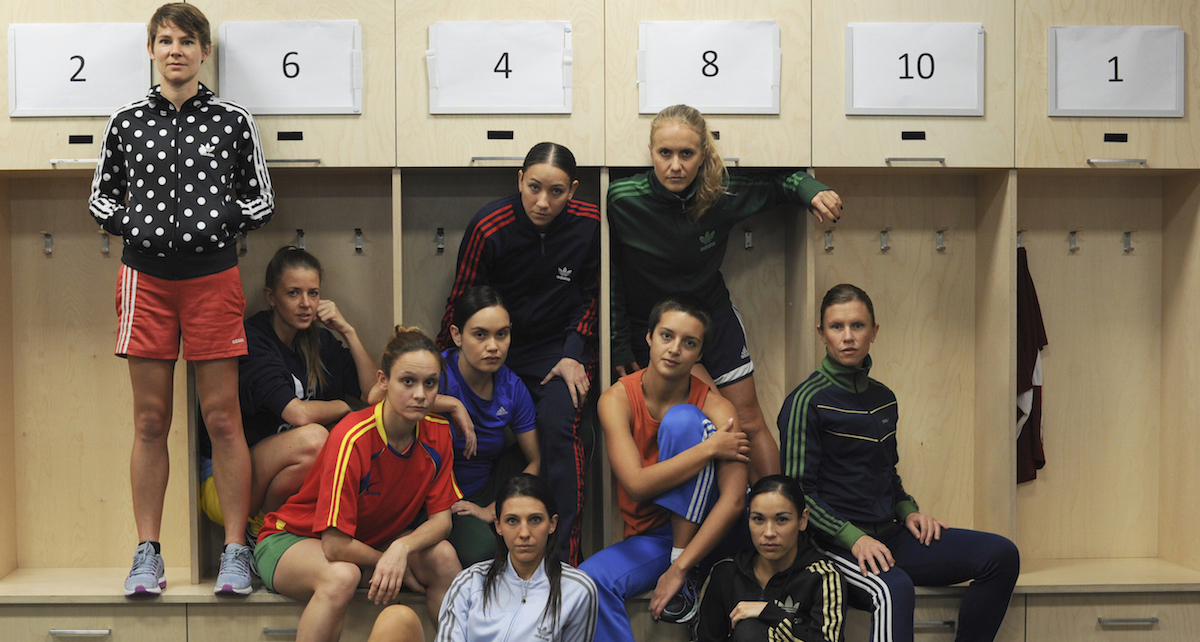It was the late Dutch maestro Johan Cruyff who once said that “dancers are the cleverest with their feet [and] next are footballers”. As one of the most gifted and creative players ever to grace the world stage, he was certainly in a position to know. Indeed, the synergies between the beautiful game and dance are quite apparent: balance, footwork, stamina, spatial choreography, the list goes on – not that many players or dancers would care to admit this publically.

‘Champions’. Photo by Heidrun Lӧhr.
Yet, despite the often entrenched enmity between sport and the arts, the 2017 Sydney Festival will kick down the wall between the two when FORM Dance Projects presents its all-female, football-themed work, Champions.
German-born football fan and contemporary choreographer Martin del Amo is clearly passionate about bringing these worlds together. “Soccer is very interesting, especially for contemporary dancers, because of course there are differences in why people take up these kinds of practises and what the purposes are, but I feel that the similarities actually outweigh the differences,” he declares.
As an Australian resident, though, del Amo is well aware of our country’s generally dismissive attitude to the arts and its pugilistic and frequently nationalistic embrace of sport. “Athletes think of artists as some sort of self-indulgent, elitist types,” he observes, “and often in the arts there isn’t that much appreciation of sport. That’s why I jumped at the opportunity when FORM approached me.”
Based in Parramatta, FORM Dance Projects exists in the heart of Western Sydney’s multi-ethnic, sports mad community (think Eels, Giants, Wanderers). It is fertile ground for a work like Champions, so much so that del Amo has been working with the Western Sydney Wanderers to research the particular physicality of the footballer and the spectacle of the game.
Champions, however, is also adding gender politics to the mix. The eleven-member cast are all female, a team that includes Miranda Wheen, Kristina Chan and Carlee Mellow. In addition, the work will feature commentary from Channel Seven commentator Mel McLaughlin.

‘Champions’. Photo by Heidrun Lӧhr.
According to choreographer del Amo, the female focus was both an artistic and political choice. “Very often, the idea of champions is usually male, and women aren’t very often appreciated in that context,” he says, “so I thought that in this collaboration of dance and soccer that this was a fantastic opportunity to break down those barriers.”
As del Amo notes, the timing is auspicious given the recent high-profile strike by Australia’s world top-ten women’s football team, the Matildas, over the massive disparity in pay and conditions between our national men and women’s teams. Somewhat ironically, this gap is perhaps only matched in their respective FIFA rankings, with the Matildas at seven and the Socceroos at 40*.
In this context, McLaughlin’s involvement is doubly powerful. As a woman working at the very epicentre of ‘heroic’ Aussie maledom, TV sport, she is a rarity. “It’s such a difficult domain for a woman to break into, in Australia especially,” del Amo contends. “She’s one of the few who has, but also who has managed to do so in a way where she has had the support of the men, because really, it’s just her expertise that impresses.”
Of course, away from the overlay of politics and culture wars, Champions is still a work of dance, and hence a performative spectacle beset with its own slew of creative challenges. First and foremost for del Amo and cast is the obvious problem of mime and mimicry associated with a work that seeks to collide physical languages and practises.
“What became clear was that it would be a mistake to try and emulate what sport does best,” del Amo reveals of the process. “You know, so having gone to some of the games, they’re so theatrical in a lot of ways and choreographic and exciting; but if we tried to emulate that as dance artists, we would always be on the back foot, and so this why we came up with the framework that this is a dance piece but it’s presented as if it was a sporting event.”

‘Champions’. Photo by Heidrun Lӧhr.
Luckily, football is replete with physical grammar, from training rituals to on-field formations and goal celebrations. That said, the translation was far from one-to-one. “We actually used soccer training as part of the research because it was a chance for the dancers to go through routines that their bodies weren’t used to and to almost re-wire their bodies,” del Amo explains.
When Champions takes to the field at Carriageworks, it is clear that several chasms will have been straddled, but the big question, as it is before every big match, is what system will the team play? 3-4-3? Counter-attacking? Diamond midfield? Del Amo laughs it off, typical coach style. He says, “I’ll do what all good coaches do and say that you’ll have to wait and see.”
Champions will be presented 17-22 January, at Carriageworks, as part of the Sydney Festival. For bookings, visit www.sydneyfestival.org.au/2017/champions.
*Based on FIFA’s November 2016 rankings.
By Paul Ransom of Dance Informa.
Photo (top): ‘Champions’. Photo by Heidrun Lӧhr.

















